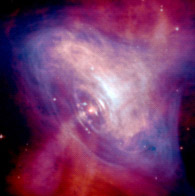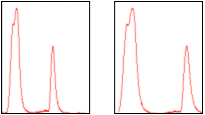Lesson Five : Pulsar in the Crab Supernova Remnant
One well-known pulsar lies at the center of the Crab Nebula in the constellation Taurus. This nebula is the result of the supernova that occurred in 1054 A.D. The Chinese first discovered this supernova remnant, describing this phenomenon as a “guest star” in the night sky.The Crab pulsar rotates 30 times every second. One pulse occurs every 33 milliseconds. The Crab pulsar is relatively young and still radiates an enormous amount of power and emits everything from radio waves to gamma rays. This pulsar generates approximately 100,000 times more radiation than our sun.
As the pulsar continues to give off radiation, it gradually spins slower and slower as more and more energy is blasted into space. The pulsar’s period lengthens by 15 millionths of a second each year.
Following the discovery of the pulsar in radio wavelengths, optical astronomers detected the pulsar in optical wavelengths, making it the first optical pulsar ever discovered.
Crab Pulsar in X-Ray (blue) Optical (red)

NASA / CXC / ASU / J. Hester et al.

NASA / CXC / ASU / J. Hester et al.
Images of pulses from the Crab Pulsar 
Moffet, D.A. and Hankins, T.H.,

Moffet, D.A. and Hankins, T.H.,